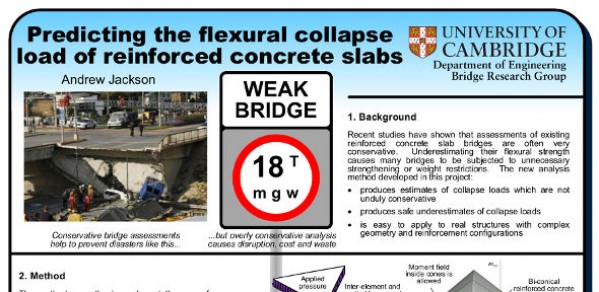
Andrew Jackson, a PhD student in the Structures Group, won the poster category at the Institution of Structural Engineers Young Researchers Conference 2009. Andrew's poster, entitled 'Predicting the Flexural Collapse Load of Reinforced Concrete Slabs', described a method that he has developed to show that some bridges which other engineers believe to be dangerous are stronger than expected, allowing existing structures to be retained and saving the cost of replacing them.
I was delighted to win this award, and greatly enjoyed the chance to see and hear about research being carried out into structural engineering all around the country. Congratulations to everyone who presented, and thanks to the Institution of Structural Engineers for organising the event.
Andrew Jackson
The method uses traditional plasticity theory, developed in the Department in the 1950s and taught to all Engineering undergraduates, combined with modern computational methods.
Andrew's supervisor Dr Campbell Middleton speaking about Andrew's work says: "I am extremely impressed with Andrew's work as I think it represents a significant advance by providing a generally applicable solution scheme for predicting the flexural strength of concrete slabs, something researchers have been attempting to derive for decades. It is difficult to speculate on how many structures Andrew's analysis method might be applied to, however earlier work in the group resulted in a novel collapse analysis program which we estimate has resulted in tens of millions of pounds in savings for bridges alone, so Andrew's solution, which has wider applicability than just bridges, has the potential to have a very significant impact in the field."

